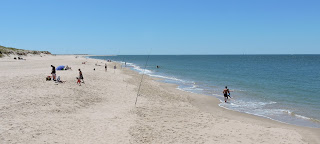 |
| Chateau Pinchon Longueville |
Yesterday, we drove from St. Emilion, on the right bank of the Bordeaux area, home to the St. Emilion and Pomerol wine regions, to the left bank of the Garonne River, north of the city of Bordeaux, encompassing Medoc, St. Estephe, St. Julien, Margaux. Graves and Pauillac. Don's heart was beating double time as we drove past the most famous of the Bordeaux vineyards, stopping to photograph some of his favorite chateaux--Chateau Laffite Rothschild, Chateau Mouton Rothchild, Chateau Latour, Chateau Lynch-Bages, Chateau Pichon Longueville.
 |
| Don outside Chateau Latour |
The left and right banks are very different. The area around St. Emilion is hilly, with medieval villages and generally very small vineyards and wineries. The chateaux are mostly low key, often in stone buildings hundreds of years old. It is not difficult to arrange a tasting at the many wineries surrounding St. Emilion. It all seems local, small and manageable. Towns are really villages, most with medieval centers that are very picturesque and charming.
 |
| roses and vines, Chateau Pinchon Longueville |
The left bank, however, is flat, with much larger vineyards and some enormous, opulent chateaux housing the wineries. The towns are mostly newer, more towns than villages, with lots of new homes in addition to a smattering of old stone buildings, though we did have lunch in the tiny, old village of Bages. Some of the most famous wines in the world are made here and sell for very high prices--hence, the gorgeous, if a bit overdone, chateaux that produce them. Wine tastings at the most prestigious wineries must be reserved well in advance.
 |
| Chateau Mouton Rothschild |
Driving out of the main wine area, we continued on to the end of the land on the left bank of the river, Pointe de Grave, where a lighthouse marks the meeting of the wide Garonne River and the Atlantic Ocean. There are a couple of towns along the road that are probably teeming with vacationers in August when France shuts down for its holidays, but right now, the long, white-sand beaches are rather empty.
 |
| Muslim mother and child at beach |
 |
| Atlantic beach at Pointe de Grave |
Evening found us in the city of Bordeaux, France's fourth largest city, surrounded by large industrial plants, including a huge Ford factory. The old part of the city is charming, with pretty neoclassical buildings, large squares, a stunning Gothic cathedral that was built over a 400 year period from the 12th to 16th centuries and the nearby 12th century Royal Gate. Other large squares have their own beautiful churches and gardens. Along the Garonne River, which provides Bordeaux' port, there is a wonderful boardwalk with an outdoor food market.
 |
| Bordeaux cathedral |
 |
| Bordeaux riverfront |
Farther along the river is the new Bordeaux wine museum, the Cite du Vin. The building is quite remarkable and the museum, itself, is fun and fascinating. Most of the exhibits are interactive as you learn about not just the very long history of winemaking around the world, but also about the language used in describing wines and what it means. You can squeeze a rubber bulb, for example, to smell the various scents of wines that depend on the terroir and the talents of the vintner. Another exhibit lets you pair different foods and wines, with an off-screen expert spitting out the wine in bad pairings (that you've chosen), breaking the wine glass, and declaring how disgusting that pairing is (and why). A separate exhibit features stories of wineries around the world, told by their current family owners.
 |
| Bordeaux wine museum--the Cite du Vin |










No comments:
Post a Comment